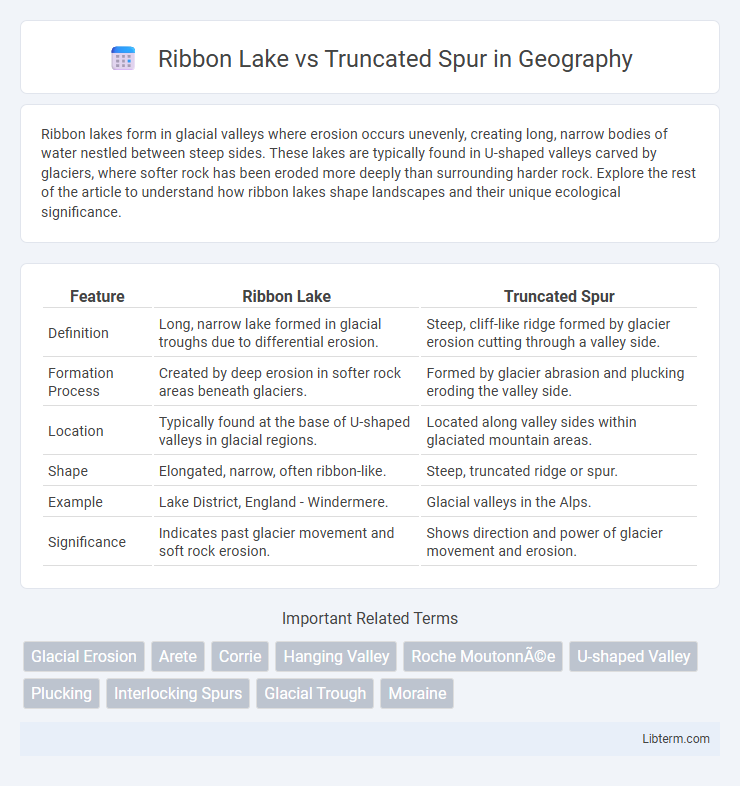Ribbon lakes form in glacial valleys where erosion occurs unevenly, creating long, narrow bodies of water nestled between steep sides. These lakes are typically found in U-shaped valleys carved by glaciers, where softer rock has been eroded more deeply than surrounding harder rock. Explore the rest of the article to understand how ribbon lakes shape landscapes and their unique ecological significance.
Table of Comparison
| Feature | Ribbon Lake | Truncated Spur |
|---|---|---|
| Definition | Long, narrow lake formed in glacial troughs due to differential erosion. | Steep, cliff-like ridge formed by glacier erosion cutting through a valley side. |
| Formation Process | Created by deep erosion in softer rock areas beneath glaciers. | Formed by glacier abrasion and plucking eroding the valley side. |
| Location | Typically found at the base of U-shaped valleys in glacial regions. | Located along valley sides within glaciated mountain areas. |
| Shape | Elongated, narrow, often ribbon-like. | Steep, truncated ridge or spur. |
| Example | Lake District, England - Windermere. | Glacial valleys in the Alps. |
| Significance | Indicates past glacier movement and soft rock erosion. | Shows direction and power of glacier movement and erosion. |
Introduction to Ribbon Lakes and Truncated Spurs
Ribbon lakes are long, narrow bodies of water formed in glacial troughs due to differential erosion where softer rock is excavated more deeply by glacial movement. Truncated spurs are steep, cliff-like features created when glaciers erode and cut off the ends of ridges that extend into valleys. Both landforms exemplify the powerful erosive processes of glaciers shaping mountainous landscapes.
Geological Formation Processes
Ribbon lakes form through glacial erosion, where elongated depressions are carved out by the movement of glaciers, typically in over-deepened valleys with varying rock resistance. Truncated spurs develop when advancing glaciers erode the tips of interlocking spurs, creating steep, cliff-like edges by cutting off their previously tapered ends. Both features exemplify distinct glacial processes that reshape mountainous landscapes by differential erosion and subglacial abrasion.
Key Physical Characteristics
Ribbon lakes are long, narrow bodies of water formed in glacial troughs where softer bedrock has been deeply eroded, often characterized by flat floors and steep sides. Truncated spurs are steep, cliff-like landforms created when a glacier cuts through interlocking spurs, resulting in sharp, steep edges rather than the rounded slopes found in non-glaciated valleys. While ribbon lakes store glacial meltwater along a valley floor, truncated spurs represent the dramatic erosional features on valley sides, showcasing the glacier's power in reshaping landscapes.
Locations and Notable Examples
Ribbon lakes commonly form in glacial troughs, with notable examples including Llyn y Dywarchen in Snowdonia, Wales, and Lake Windermere in the Lake District, England. Truncated spurs are prominent in glacial valleys where glaciers have cut through interlocking spurs, with well-known cases such as the truncated spurs in the Riffelalp region of the Swiss Alps and Yosemite Valley in California. Both landforms are key indicators of past glacial activity in mountainous terrains across Europe and North America.
Formation Stages: Glacial Influence
Ribbon lakes form during glacial periods when glaciers erode deep, narrow valleys by plucking and abrasion, often over softer rock layers, creating long, thin lakes once the ice retreats. Truncated spurs result from glaciers cutting through interlocking valleys, shearing off their tips with powerful erosive force, leaving steep cliff faces along valley sides. Both features showcase direct glacial influence in progressive valley shaping, with ribbon lakes indicating zones of differential erosion and truncated spurs evidencing glacier-driven valley widening.
Ecological Significance and Impact
Ribbon lakes, formed in glacial troughs, provide unique aquatic habitats supporting diverse flora and fauna, contributing significantly to local biodiversity and water regulation. Truncated spurs, resulting from glacial erosion truncating valley ridges, influence microclimates and soil distribution, affecting vegetation patterns and wildlife corridors. Both glacial features play crucial roles in shaping ecological landscapes, enhancing habitat complexity and promoting species diversity in post-glacial environments.
Human Interaction and Utilization
Ribbon lakes, elongated depressions formed by glacial erosion, often attract tourism and recreational activities such as boating and fishing, enhancing local economies through sustainable development. Truncated spurs, steep cliffs created by glacier movement cutting through interlocking valleys, present challenges for infrastructure but are valued for their dramatic landscapes, influencing hiking trail design and conservation efforts. Both landforms play key roles in regional land use planning, balancing natural preservation with human access and economic benefits.
Differences in Erosion and Deposition
Ribbon lakes form through differential erosion in glacial valleys, where softer rock erodes more deeply beneath the glacier, creating long, narrow lakes. Truncated spurs result from glacial abrasion and plucking, where protruding valley spurs are cut off sharply by the advancing ice, altering the landscape's profile. Ribbon lakes represent deposition and water accumulation in over-deepened sections, while truncated spurs primarily showcase erosional reshaping of existing landforms by glacier movement.
Comparative Table: Ribbon Lake vs Truncated Spur
Ribbon lakes, elongated water bodies formed by glacial erosion in over-deepened valleys, contrast sharply with truncated spurs, which are steep, cliff-like ridges cut by glacial movement. Ribbon lakes typically occur in U-shaped valleys where softer bedrock is eroded below harder rock, whereas truncated spurs result from glaciers truncating pre-existing river spurs, creating sharp, steep faces. The comparative table highlights ribbon lakes' characteristics of water accumulation and depression formation versus truncated spurs' features of ridge deprivation and steep, angular slopes.
Conclusion: Geological Importance and Preservation
Ribbon lakes and truncated spurs both exemplify classic glacial landforms, showcasing distinct processes of erosion and deposition critical to understanding Pleistocene glaciation. Ribbon lakes indicate deepened valleys carved by concentrated ice flow, while truncated spurs reveal the powerful erosive force of glaciers cutting through pre-existing ridges. Preserving these features is essential for geological research, landscape education, and maintaining natural heritage that illustrates past climate dynamics and glacier behavior.
Ribbon Lake Infographic

 libterm.com
libterm.com